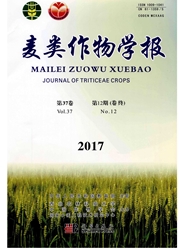

 中文摘要:
中文摘要:
为给小麦缺素症早期诊断提供依据,以太湖地区典型稻麦轮作区的长期定位施肥实验为研究对象,分析了氮磷钾单一营养元素缺乏和两种或两种以上元素同时缺乏时的小麦叶绿素含量(SPAD值)及冠层反射光谱特性的变化规律。结果表明,缺素造成了叶片叶绿素含量的下降。缺氮使小麦冠层光谱反射率在可见光波段(460~710nm)和1480~1650nm波段增加,在近红外波段(760~1220nm)下降,红光波段对胁迫表现最为敏感.其次为黄光波段和1480nm左右的水分吸收波段;缺磷降低了近红外波段反射率,对可见光波段反射率的影响则受生育阶段和其他肥料互作的影响;缺钾处理对冠层反射光谱的影响较小,差异不显著。氮胁迫对可见光波段的影响程度显著高于磷胁迫,近红外波段两者持平。光谱对养分胁迫的响应程度随生育进程的推进而逐渐减小。缺素均使冠层光谱的红边位置向短波方向移动即发生蓝移,位移大小依元素缺乏种类及数量而定,最大位移可达10nm左右。
 英文摘要:
英文摘要:
This study was conducted to examine the effect of single element-deficient or two or three element co-deficient on wheat leaf SPAD value and canopy spectral reflectance and test the possibility of early nutrient deficient detection. Results showed that all nutrient deficiencies reduced leaf chlorophyll content (SPAD value) and N was the most significant influencing factor, then P. N-deficiency increased the reflectance at visible (460~710 nm) and 1 480~1 650 nm band, and reduced the reflectance at NIR band (760-1 220 nm), with the most sensitive band of red, then yellow band and water absorption band at 1480 nm or so. P-deficiency reduced the reflectance at NIR band, and its influence on visible band was depending on the crop developing stage and other nutrient status. The influence of K deficiency on canopy reflectance was small and not significant. The impact of N-deficiency on canopy reflectance was stronger than P-deficiency at visible band, while equal at NIR band. Nutrient deficiencies caused a shift of red edge toward shorter wavelengths, namely blue shift. The shift magnitude depends on the element and can be reached 10 nm or so.
 同期刊论文项目
同期刊论文项目
 同项目期刊论文
同项目期刊论文
 期刊信息
期刊信息
